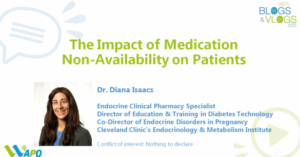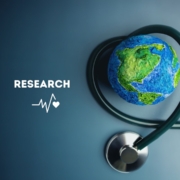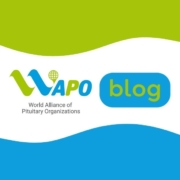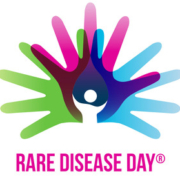2025 Blog 4 – The Impact of Medication Non-Availability on Patients
In this new edition of the 2025 WAPO Blogs and Vlogs series, we were lucky enough to be joined by Dr. Diana Isaacs, a clinical pharmacy specialist in endocrinology and director of education & training and diabetes technology at the Cleveland Clinic in Cleveland, Ohio. In this interview, Dr. Isaacs shares her expertise on a vital topic that is not discussed enough: the impact of medication unavailability on patients.
This article provides a summary of the Vlog interview that you can find in English and Spanish on the WAPO website’s Library and YouTube channel.

What are the most critical medications for patients with endocrine conditions and what are the health risks when these treatments are unavailable?
Dr. Isaacs started by highlighting the critical role that medications play in managing different endocrine conditions, including pituitary disorders and adrenal insufficiency. She started by talking about one of the most essential classes of medication used for adrenal insufficiency, which is glucocorticoids, or steroids, often prescribed in the form of hydrocortisone. This medication is vital for many physiological functions including the body’s stress response, blood pressure regulation, immune system function, and the metabolism of proteins, carbohydrates, and fats. It is the most prescribed drug in its class, as it mimics the body’s natural way of producing cortisol. She then talked about mineralocorticoids, such as fludrocortisone, which are prescribed as aldosterone replacement therapy. Aldosterone is a hormone essential for balancing electrolytes and fluids in the body as well as maintaining a healthy blood pressure. In patients with adrenal insufficiency, not having access to these types of medications can lead to a life-threatening medical emergency known as an adrenal crisis.
Dr. Isaacs then provided another example of a critical medication, called desmopressin, which is very important for a pituitary disorder called arginine vasopressin (AVP) deficiency (previously known as central diabetes insipidus). In patients with AVP deficiency, desmopressin replaces vasopressin, a hormone essential for proper fluid balance in the body as it signals to the kidneys to retain water.
She also touched on diabetes, where insulin is a cornerstone of treatment. “Insulin is life-sustaining, especially for people with type 1 diabetes,” she said. Some people with type 2 diabetes also rely on insulin to manage their blood sugar levels, so the lack of access to this treatment can quickly become a life-threatening emergency. Inadequate levels of insulin over time can also lead to serious complications, such as vision problems, neuropathy (manifesting with tingling in the hands or feet) and cardiovascular disease, which increases the risk of heart attacks and strokes.
It is clear that having access to medications for all of these endocrine conditions is not just about symptom management, and can be the difference between life and death.
How does the unavailability of medications affect a patient’s quality of life and mental well-being?
Dr. Isaacs emphasized that medication shortages can have a negative impact on a patient’s mental health and quality of life. The uncertainty around accessing life-sustaining medications can understandably lead to significant stress, anxiety, and in some cases, dangerous decisions like rationing doses. She shared the story of a patient who, during a period of insulin shortage, began sharing her insulin with a family member. As a result, neither person was getting the full dose they needed, leading to poorly controlled blood sugar levels. Unfortunately, the patient did not inform her care team about the rationing. When her blood sugars remained high, her healthcare provider assumed the medication dose was too low and increased it. Later, when the patient had full access to insulin again and began taking the prescribed amount, it caused hypoglycemia, a dangerous drop in blood sugar. This example illustrates how limited access to vital medications can have serious consequences.
Patients also face increased anxiety, depression, and irritability when not receiving their medication, especially those with adrenal or pituitary disorders, as hormone levels directly impact mood and energy.“When people are not getting the right doses of their medications, they do not feel well,” she noted. This can lead to overwhelming fatigue, disrupt daily functioning and can have a huge emotional toll. We therefore need to be doing everything possible to reduce this burden.

What are the main causes of medication unavailability for these conditions?
When asked about the causes of medication unavailability, Dr. Isaacs explained that the problem is complex and multifactorial in nature. Causes may include:
- Manufacturing and Quality Control Issues
These are consistently identified as the most frequent causes of drug shortages. Problems like production delays, unexpected facility closures, or quality control failures, can quickly disrupt the supply chain.
- Unpredictable Demand
Sometimes demand for a medication far exceeds what manufacturers anticipated. Dr. Isaacs gave the example of glucagon-like peptide-1 receptor agonists (or GLP-1 drugs), which experienced an explosion in demand that took time to catch up with.
- Low Demand for Rare Disease Treatments
In rare conditions like adrenal insufficiency or acromegaly, medications may be harder to source simply because the patient population is smaller so there is less demand. With fewer financial incentives, manufacturers may not prioritize production. Sometimes the economic dynamics do not support consistent supply and this is where governmental incentives are essential. They may also be more complicated to manufacture and require more time to be produced.
- Natural Disasters
Environmental events can have a sudden and severe impact on drug production. An example is Hurricane Helene, which disrupted a major IV fluid production facility in the U.S., causing widespread shortages of saline solution. As climate-related disasters become more common, this is something we need to better prepare for.
- Global Supply Inequities
When supply is low and demand is high, prices naturally rise. This often negatively impacts poorer countries (as well as rural areas), which may not be able to compete with wealthier nations for access to these medications.

How do healthcare providers adapt treatment plans when essential medications are unavailable?
Dr. Isaacs started by saying that generally, healthcare professionals are alerted about shortages. In the U.S., organizations like the American Society of Health-System Pharmacists (ASHP) and the U.S. Food and Drug Administration (FDA) help providers stay updated on which medications are currently unavailable and whether alternatives exist. In Europe, the EMA has a public information page on medicine shortages and Canada has Health Canada’s drug shortage reporting website, as do several other countries. However, there are occasions when patients can be the first to find out about a shortage and report it to their doctor. When a shortage occurs, she offered reassurance saying that, “fortunately, we can get creative and there are usually ways to work around it and use other medications, but it can be very challenging.”
She gave an example of the hydrocortisone emergency kit. It is a ready-to-use form of hydrocortisone, which is used by patients with adrenal insufficiency, in case of stress or illness. She shared that this kit has recently been on shortage and is unfortunately expected to be on shortage through next year. Alternatives to the kit do exist, but they require reconstitution by mixing the powder and liquid before injection. So there is a solution, but it requires more time, understanding, and educating patients and their carers on how to use it.
In the event of a cortisone shortage, she said that, “we have alternatives.” They can use hydrocortisone, or other steroid-type drugs like prednisone. The challenge is that they do not work quite the same way, and there may be some impacts on patients in terms of finding the perfect dose. That is why individualized care, led by an experienced endocrinology team, is crucial to getting patients stabilized during a switch.
Dr. Isaacs also touched on insulin shortages and the manufacturer-led discontinuation of a brand of long-acting insulin analog, which forced many patients to transition to alternatives. While a one-to-one dose switch can often work, she stressed that these adjustments typically require tailoring over time. The same goes for fast-acting insulin, which may affect patients differently and require additional support to manage low blood sugar levels, as needed.
She also brought up a recently publicized topic: the GLP-1 drug shortages and how they were largely driven by an increase in public demand. These drugs have been effective for many patients managing type 2 diabetes and obesity, but their abrupt discontinuation can lead to rapid weight regain and spikes in blood sugar. Shortages can therefore be challenging and healthcare providers often need to introduce additional medications to stabilize blood sugars, as well as reinforce nutrition (with the help of a dietician), lifestyle, and physical activity strategies to avoid weight fluctuations.
Fortunately, many of the shortages, like those of the GLP-1 drugs, have now been resolved. However, this experience underscores the importance of communication, patient education, and a multidisciplinary approach when access to vital medications becomes uncertain.

What policy, supply chain, or healthcare system improvements are needed to ensure consistent access to critical medications and prevent future shortages?
Looking ahead, Dr. Isaacs acknowledged that while it may not be possible to prevent every medication shortage, there are proactive steps that can reduce their frequency and severity.
She outlined several key areas for improvement, starting with operational strategies. This includes establishing early warning systems to alert healthcare providers and manufacturers when a shortage might be approaching. New technologies, such as artificial intelligence, could help predict shifts in supply and demand, prompting increased production before a shortage becomes critical. From a policy perspective, Dr. Isaacs emphasized the need to incentivize manufacturing, ensure a reliable supply of active pharmaceutical ingredients, and streamline the regulatory approval process, particularly for medications used in rare conditions. While these conditions may be less common than diabetes or obesity, having access to these medications are vital for patients.
She also advocated for stronger international strategic partnerships, as there may sometimes be a shortage in one country but plenty of the medication in other countries. Open communication between nations could help redistribute supply more equitably, ensuring that access is not limited to where someone lives.
Another essential piece of the puzzle, Dr. Isaacs stressed, is professional and public advocacy. Policymakers must understand just how critical it is for patients to have reliable access to their medications, whether for adrenal insufficiency, diabetes, or other endocrine conditions. Raising awareness is vital so that we no longer hear stories of patients forced to ration their medication, or worse, because they could not get what they needed. “This is not a luxury or a nice-to-have,” she concluded. “This is truly life-sustaining.”
We would like to thank Dr. Isaacs for taking the time to discuss this important issue with us. By raising awareness and advocating for sustainable, equitable access to life-sustaining medications, we can help prevent not only medication shortages but also broader accessibility challenges faced by our community.
Additional Resources:
Aguero D, Allen D. Weathering The Storm: Commentary on the Hurricane Helene IV Fluid Shortage. J Pediatr Pharmacol Ther. 2024 Dec;29(6):667-669. doi: 10.5863/1551-6776-29.6.667. Epub 2024 Dec 9. PMID: 39659851; PMCID: PMC11627566.
de Silva, Nipun Lakshitha et al. “Global Barriers to Accessing Off-Patent Endocrine Therapies: A Renaissance of the Orphan Disease?.” The Journal of clinical endocrinology and metabolism vol. 109,5 (2024): e1379-e1388. doi:10.1210/clinem/dgad610
de Graaf, J., Bruegmann, P., White, E., & de Rijdt, D. (2024, December). Multistakeholder mapping of endocrine medicine availability and shortages in Europe: ENDO-ERN expert centres [Poster presentation]. ERICA ERN Research Conference (GA2024), Udine, Italy.
The American Society of Health-System Pharmacists (ASHP) drug shortages page
The EMA’s Public information on medicine shortages page
Health Canada’s Drug shortages homepage








